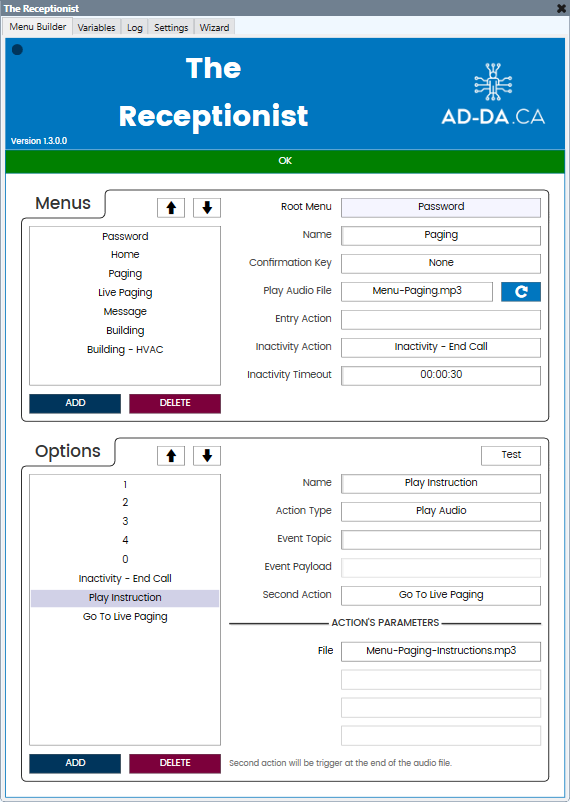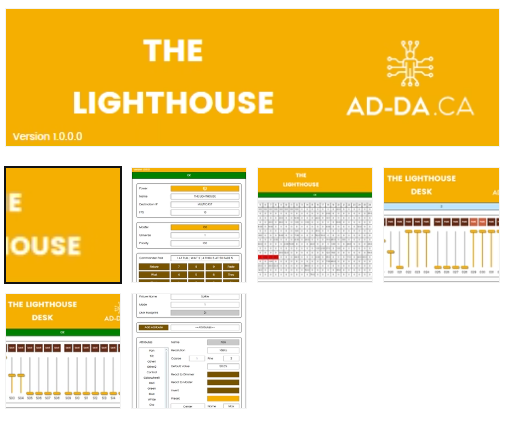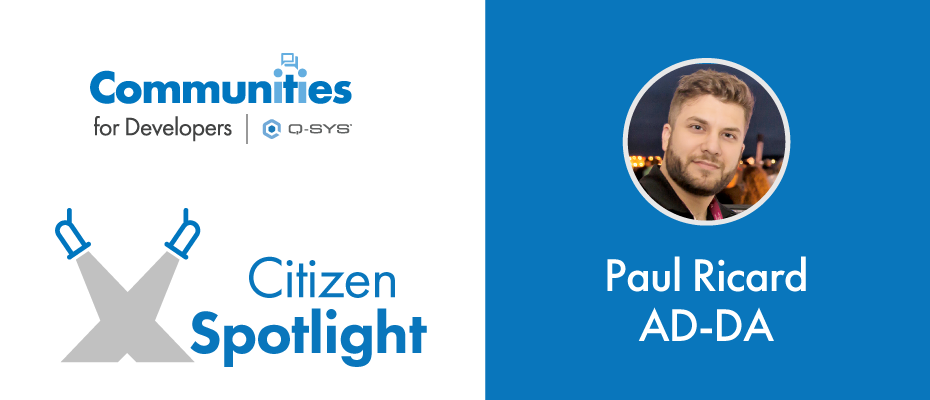Today we are highlighting the work of Paul Ricard, another inspiring citizen from Q-SYS Communities for Developers. Coming from a live events background, he discovered Q-SYS after an opportunity to automate equipment within a commercial AV environment. This prompted him refocus on programming and launch his own company, AD-DA.ca which is also a member of the Q-SYS Developer Partner Program. Let’s get to know more about Paul and his contributions to the Q-SYS ecosystem.
Q&A
TF: Paul, thanks so much for meeting with us. Let’s start with you telling us about your education background and history with Q-SYS.
PR: Technology has been part of my life from a young age. I started with a computer science program in high school and continued with collegial studies in Recording and Audio Engineering. I then spent ten years working as an audio engineer and a system engineer.
In 2015, due to a special request from a client who needed help automate their equipment, I was introduced to commercial AV. Coming from the world of live events, I hadn’t been in touch with this type of work before. It was a game changer for me. At the time, I managed to offer a custom solution with the little knowledge I had. Then, doing more research on the subject, I found out about Q-SYS. The following year, I decided to launch my own company and concentrate on programming which is my favorite part of working in the AV field.
Basically, AV is an art I have been perfecting every opportunity that I have for 20 years and counting. Furthermore, programming is not only a job for me; I practice it even in my personal life through my interest in home automation.
TF: Could you highlight some of the contributions to the Q-SYS Ecosystem from an independent developer and from a Q-SYS Developer Partner perspective?
PR: My first contribution to the Q-SYS ecosystem was the Home Assistant plugin, which is the result of a personal need for managing a home automation system. It was my first step into this ongoing journey.
I was then asked by one of my clients, a higher education institution, to create a solution that would generate different emergency evacuation actions through a phone system. That led to The Receptionist, a plugin that can now be used for setting off any action programmed by using a phone keypad. If you would like to use The Receptionist plugin, you can find it in Q-SYS Designer Asset Manager.

Another of my contributions is called The Lighthouse, a plugin that adds the functions of a professional stage lighting console to the existing system.

Globally, I create plugins that I will enjoy using, but delivering them to the Q-SYS communities raises the level of rigor with which they are produced. I also tend to make them more versatile. They answer a universal need more than a client-specific need, which makes them more scalable to deploy and use in different contexts.
TF: How do you stay up to date with AV technology? What upcoming technologies excite you and how do you think Q-SYS could leverage the future for a better user and developer experience?
PR: Online training is obviously a key to staying up to date, but what I find helps the most is using the Q-SYS platform on a daily basis. It keeps me connected with the programmers’ needs.
Regarding upcoming technologies, although AI seems to be the answer to most questions, I try to keep my mind open as to what exactly is going to be the next significant milestone in the world of programming. Adding web protocols, such as HTML5, to the Q-SYS platform could make the UCIs easier to use for the clients and also would improve interoperability between devices for the developer.
TF: What tools and resources do you think every Q-SYS Designer or Q-SYS plugin developer should have in their arsenal?
PR: Designers and developers should have skills in three different fields: computer science, AV technology and networking. It is the combination of knowledge in these three fields that helps me be proficient at what I do. And, as I mentioned earlier, the skills and expertise gathered by being a loyal user and staying with the Q-SYS technology are probably the most important.
TF: Going back to education, how might you do it differently if you had to relearn everything today?
PR: I had to learn programming on the job, which worked out fine but slower than if I had taken a class. Had I done things differently, I would have chosen a more structured path to learn multiple languages, and I would probably have started a little earlier in my life when free time was less of an issue.
TF: What is your advice on creating scalable solutions with Q-SYS while ensuring a great user experience?
Whatever the start size of a task, I apply a consistent work methodology. By using the same template, I can easily go back to a project and expand or adapt it.
Another very important thing is not to underestimate error handling. Every possibility of errors should be explored so as to program a response that will not leave the user in a dead-end. Both the programmer and the user will benefit from a design that manages errors, whether they are induced by human interaction or a system failure.
Furthermore, targeting a specific need and understanding exactly how the product will be used is essential to creating a satisfying solution for the client.
TF: Do you have any feedback to other programmers looking to grow as a developer wanting to work with Q-SYS? Any challenges that were overcome with joining the Developer Partner Program (DPP)? What are paths to grow revenue as an independent developer for the AV industry and working with manufacturers?
In order to grow as an independent programmer, it is important to secure revenue by identifying the specific needs of your target market. In my experience, education institutions and corporate conference rooms offer endless opportunities to set up and update AV solutions. Once your revenue is secured, you will be able to free time and resources to start developing new projects.
Joining the DPP made communications between the clients and me more effective. It was easier for clients to find my contact details, which brought me more feedback. Also, by better understanding the Q-SYS structure, I found answers to my questions more easily.
TF: As an independent programmer working with Q-SYS, what is the value of a platform like Communities for Developers to you? Are there ways we can improve the platform to help you more in your role within the Q-SYS Ecosystem?
PR: Communities for Developers is an endless source of ideas for new plugins or for specific features that could be added to the existing ones. I also consult the platform to better understand how people use the products.
Although Communities for Developers is generally very effective, the SDKs and user guides could benefit from an interactive function to submit changes, just like Wikipedia’s. Making modifications directly in the document and having a moderator approve the correction could speed up the process of signaling and correcting mistakes.
TF: What are your thoughts regarding the future of the AV Industry and where it will be in the next couple years? Where do you think breakthroughs in technology will come from?
PR: AI and automatic learning will certainly help the users of the tools we create as programmers. I believe the system will get better at suggesting functions and optimal configurations according to the equipment detected in a room, for example.
Another major breakthrough will come from the emergence of protocols such as Dante Connect. With such an innovation, signals won’t need to be processed through a local network anymore, since it will be done over the cloud instead.
TF: Where can we find your work?
PR: You can find The Receptionist plugin on Q-SYS Designer Asset Manager. All of my other plugins are available on my website: ad-da.ca
